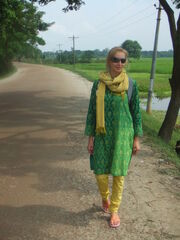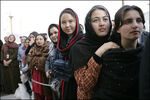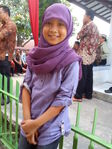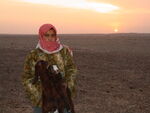
Muslim Women Should Dress This Way (Or That Way)
Muslim Women Should Dress This Way (Or That Way).

Americans Vacationing In Iran NBC News
NBC News.
Women's rights and public morality[]

Talat Basari in the 1960s. The Islamic revolution said women must cover there arms, legs and hair. Basically, according to the revolutionary law, she would have looked tarty and rude in this image.

A modern Iranian woman in more appropriate clothing.
The Quran does not specify specific gender roles for women. In only a few instances are circumstances men and women notably different in the Qur'an. Passages that seem to affirm male authority over women are based on the Islamic understanding that men are responsible for the financial support of women. While the Qur'an allows a Muslim man to take up to four wives, it also insists on equal treatment for all. In most Islamic practice, gender roles manifest themselves, partially because men and women are sometimes allotted different rights and different cultural expectations. Islamic Women are often expected to be obedient and loyal wives and later mothers, staying within the family environment, while men are expected to be protectors, bread winners and caretakers of the family.
Several passages of the Quran deal with acceptable dress for both men and women. Sura 24, Verses 30-31 states:
"And tell the believing men to lower their gaze and be modest. That is purer for them. Lo! Allah is aware of what they do. And tell the believing women to lower their gaze and be modest, and to display of their adornment only that which is apparent, and to draw their veils over their bosoms, and not to reveal their adornment save to [those relatives who fall within bounds of close relationship explained in the Qur’an]..." Chapter 24, Verses 30-31
"O Prophet, tell your wives and daughters, and the believing women, to cover themselves with a loose garment. They will thus be recognised and no harm will come to them" [Qur'an 33:59]
“Say to the believing men that they should lower their gaze and guard their modesty: that will make for greater purity for them: and Allah is well acquainted with all that they do.” [Al-Qur’an 24:30]
“And say to the believing women that they should lower their gaze and guard their modesty; that they should not display their beauty and ornaments except what (must ordinarily) appear thereof; that they should draw veils over their bosoms and not display their beauty except to their husbands, their fathers, their husbands’ fathers, their sons…” [Al-Qur’an 24:31]
According to Qur’an and Sunnah People should were a 'hijab' and their clothes should be:
- The extent of covering obligatory on the male is to cover the body at least from the navel to the knees. For women, the extent of covering obligatory is to cover the complete body except the face and the hands up to the wrist.
- The clothes worn should be loose and should not reveal the figure.
- The clothes worn should not be transparent such that one can see through them.
- The clothes worn should not be so glamorous as to attract the opposite sex.
- The clothes worn should not resemble that of the opposite sex.
- The clothes worn should not resemble that of the unbelievers, i.e. they should not wear clothes that are specifically identities or symbols of the unbelievers’ religions.
The general moral conduct, behaviour, attitude, family life and intention of the individual are also regulated by this and related ideals.
Muslims can't drink alcohol or take hallucinogenic drugs and getting them intoxicated is considered evil. Gay/lesbian sex and fondling are also banned for being evil and perverted, especially for Muslims. Western youth culture is regarded as in poor taste.
Modern, drunken, sexed-up, Western, consumer driven, hedonistic, scantily clad, house parties are (as far as I know) seen as an abomination only available to non-believers.
Saudi abaya laws[]
The abaya is most common in countries with large Muslim populations. Some denominations of Islam consider the entire female body, except for the face and hands, awrah – that which should be concealed in public from males unrelated by blood or marriage.
Outside the few Arab states and Saudi Arabia, in nations with large Muslim populations, such as Indonesia and Pakistan, not everyone wears it. In Saudi Arabia, women are required to cover in public, and to use an abaya if they are not a viseting non-belive .
An interesting point on 1970's Morocco.[]

Morocco: Keugdo for his food great Fied. Preparing meals at the October 1978 Sheep Festival. Moroccans in various outfits in 1978.
The generation gap is apparent in the clothing. A 40-45 year old dressed prudish with a scarf, a 35-40 year old dressed prudish with out a scarf and a 20-25 year old dressed in 'rude and tarty' cloths and a bare head. The youngster is in theoretically facing trouble with god in the afterlife.
Women (as an outsider can know) should wear a headscarf or hat, baggy trousers or a long full skirt and a baggy top with long sleeves and no deep necklines. Both in private and in some urban settings things have got tighter and skimpier in recent times.
Bikinis, strappy tops, hot-pants and heavy make-up are defiantly forbidden and are considered immoral stuff that would only appeal to whores.
From a outsider's viewpoint, It appears that women can dress freely with their family in their homes, but not with others or outside the home. Heads are to be covered in a house of pair. Children under the age of puberty only need to cover their rude parts, but above that age they should dress like an adult. Burkas are too extremist. Western clothes are OK, but not rude stuff (Maxi-skirts are in, mini-skirts are out).
The clothes[]
Overview[]

A Western woman tourist in Bangladesh wearing a yellow churidar (tight, long trousers) and dupatta (scarf) with a green kameez (loose, long top) on the 9th of September, 2006 at 03:49:03. It is the popular clothing article in Bangladesh, Pakistan, Kashmir, Hyderabad and non-Taliban parts of Afghanistan.

Modesty in dress is a relative cultural concept, even in the West, as seen above in the dresses of Amish Christians women on an American beach in 2007. They are 'modest' in Islamic dress terms.
Tourists are welcomed from most places, but Israelis are not welcome in several nations and are viewed as both Palestine's and Iran's sworn enemy.
Women (as far as I know) should were a head scarf, baggy trousers and\or a full skirt, a baggy top with long sleeves and no deep necklines. In private and some urban settings things have got tighter and skimpier in recent time. Bikinis, strappy tops, hot-pants and heavy make-up are defiantly forbidden and are considered immoral stuff that would only appeal to whores.
It’s not intended to insult women to expect them to wear proper Islamic clothing, but religion and sexual restraint are a big issue in the region.
Adults[]

How to Dress in the Middle East
How to Dress in the Middle East.
Some nations like Turkey and Lebanon are rather liberal and others like Saudi Arabia and ISIL are hard liners. If you are going to go into any mosques the rules are much more restrictive and you will have to cover both your whole body and all of your hair.
Trousers, skirts and tops should be loose fitting. There aren’t any footwear taboos. Women's shoulders and knees must covered. Generally most types of baggily shaped long sleeved t-shirts, non-revealing blouses, trousers and long skirts are OK. Heads are to be covered in mosques.
Bikinis, strappy tops, hot-pants and heavy make-up are defiantly forbidden and are considered immoral stuff that would only appeal to whores.
See-trough tights, vest tops, little-black-dresses, lycra shorts, boob-tubes and mini-skirts are regarded as very vulgar a only useful as underwear.
Short sleeves, short skirts, tight lycra leggings, ski-pants, halter-necked tops, gypsy-tops, tight jeans, shorts and plunging necklines are also considered too rude to be worn in public.
Headscarfs are to be warn in mosques and more severe nations. Covering your head is not necessary in most countries outside of the mosques, but a hat or cap is the best thing to were on a hot or sunny day to help protect your head.
Women should take note of this both out of respect to the local sensitivities, in order to avoid sticking out any more than they already do so as to avoid any remarks that such inappropriate dress might provoke.
Kids[]

How to Pack for Traveling Kids
How to Pack for Traveling Kids.

Best Products for Traveling with Kids Rachel's Haul ULIVE
Best Products for travelling with kids.
Generally most types of baggy short sleeved t-shirts, non-revealing blouses, trousers and long skirts are OK. Heads may be covered in mosques. Hats and caps should be worn on hot and sunny days to protect there heads.
What female tourists should were in Iran[]

Young tourists flock to Iran
Hostels are becoming more and more popular in Iran, catering to a growing number of young international tourists traveling on a budget.

American's Experience in Iran "The Children of Adam" (5 min short)
American's Experience in Iran :"The Children of Adam" (5 min short).

Americans Vacationing In Iran NBC News
NBC News.
The religious ideal[]
Several passages of the Quran deal with acceptable dress for both men and women. Sura 24, Verses 30-31 states:
"And tell the believing men to lower their gaze and be modest. That is purer for them. Lo! Allah is aware of what they do. And tell the believing women to lower their gaze and be modest, and to display of their adornment only that which is apparent, and to draw their veils over their bosoms, and not to reveal their adornment save to [those relatives who fall within bounds of close relationship explained in the Qur’an]..." Chapter 24, Verses 30-31
"O Prophet, tell your wives and daughters, and the believing women, to cover themselves with a loose garment. They will thus be recognised and no harm will come to them" [Qur'an 33:59]
“Say to the believing men that they should lower their gaze and guard their modesty: that will make for greater purity for them: and Allah is well acquainted with all that they do.” [Al-Qur’an 24:30]
“And say to the believing women that they should lower their gaze and guard their modesty; that they should not display their beauty and ornaments except what (must ordinarily) appear thereof; that they should draw veils over their bosoms and not display their beauty except to their husbands, their fathers, their husbands’ fathers, their sons…” [Al-Qur’an 24:31]
The idea[]
It is to avoid the foreign women from commiting sin in Islamic law looking like rude trollops and thus tuning men on. Natve women are subjet to the same laws to.
The rules[]
There are some basic minimum requirements for foreign women's dress-code in Iranian public places, but generally the law is looser when it comes to tourists, except in holy places. Western style clothing is accepted in private homes and some hotel rooms.
What you should were[]
- Using lighter colors in summer and darker ones in the winter.
- All hair should be covered, except for a fringe if you have one. Hats, caps and scarves can do this.
- The body should be covered with loose clothes and both the neckline, neck, décolletage and arms should not be bare. A tunic, peasant blouses or a long tank top that is layered up with a light cardigan going down to the mid-thigh.
- The legs should be covered down to ankles. Feet can be bare or in sandals. Tight jeans are no problem if under a knee length top or short skirt. Full length culottes, loose full length trousers, loose fitting maxi-dresses, loose fitting maxi-skirt should do. A loose dress that can be paired with skinny jeans.
- Open-toed sandals are tolerated, but flat shoes, ballerinas or a sneakers are better. Solid flat boots are best in the colder seasons.
- Heeled boots are the snobby and stuck-up style for rich girls in the city.
- Painted nails on your fingers or your toes are allowed.
- A chador is when visiting certain mosques at certain times. You will be loaned a chador (literally ‘tent’ in Farsi) when necessary and told how to wear it.
- Make-up, especially heavy make up and flashy lipstick , is an important part of the loose, urban, teenage underground party seen and it's youth centric style.
- Cropped pants are OK as long as they are just above the ankle.
- Capri pants, Mini-skirts and hot pants are too short.
- Strapy tops and vest tops are not allowed.
- Trendy women in Tehran were wearing their scarves as high and as far back on their heads as possible, many as a political statement, to the annoyance of the Morality Police. This style is relatively easy to do if you have long hair, since the scarf can be draped over a high ponytail or bun, which thus anchors it; but it’s impossible for those with shorter hairstyles.
- Moral offenses local women and some tourists may be done for included wearing sunglasses above the headscarf, failing to wear a coat that fully covered their bottom, wearing bright colours, wearing nail polish, wearing sandals that show the feet or ankles, and not fully covering their hair.
Hard line towns and cities[]
Some cities in Iran such as Kerman, Yazd, Kermanshah, and Kashan are more conservative, so were the local Islamic outfits.
When to use it[]
The following of the dress-code is necessary form the time of on-boarding international flights and is usually requested when the plane enters the Iranian boundaries on Iranian operated flights.
Law enforcement[]

Traffic police regulate Iran's dress code-0
Traffic police regulate Iran's dress code.
The Islamic religious police (Arabic: مطوع muṭawwiʿ, plural مطوعون muṭawwiʿūn – derived from classical Arabic: mutaṭawwiʿa/muṭṭawwiʿa) is the official vice squad of some Islamic states, who on behalf of the state, enforces Sharia law in respect to religious behavior, morality, and\ or the precepts of Wahhabism. The word mutaween (المطوعين muṭawwiʿīn; variant English spellings: mutawwain, muttawa", mutawallees, mutawa’ah, mutawi’, mutawwa') most literally means "volunteers" in the Arabic language, and is commonly used as a casual term for the government-authorized or government-recognized religious police (or clerical police) of Saudi Arabia. It was originally a casual synonym for the religious police of Saudi Arabia. The formal short term for the Saudi religious police is هيئة "hay'ah". Saudi Arabia and Iran enforce hijab on locals with such a police unit.
Sharia patrols, also referred to as Muslim patrols or modesty patrols, were groups of young Muslim men, members of an organisation that called itself the Shariah Project, who patrolled streets in East London from 2013 to 2014. The Muslim East London Mosque community condemned the patrols as "utterly unacceptable". In response to the 'Muslim Patrols', the far-right organisation Britain First has established 'Christian Patrols'.
Pakistan has no laws banning or enforcing the ħijāb. Surveys conducted in Pakistan show that most women wearing the ħijāb do so of their own choice. Most women wear the Shalwar Kameez, which consists of a tunic top and baggy trouser set which covers their arms, legs and body. A loose dupatta scarf is also worn around the shoulders, upper chest and head since showing ones hair is considered rude and in bad taste. Men also have a similar dress code, but only women are expected to wear a veil and\or a scarf in public. Most ħijāb and Burquas are worn in rural Islamist areas.
Images[]
Videos[]

Muslim fashion 'Anyone can wear these clothes'
Muslim fashion: 'Anyone can wear these clothes'.

Iranian woman talk about election in Iran دختر ایرانی در بارە انتخابات صحبت می کند
Iranian woman talk about election in Iran. Note that she is in morally upright clothes so the bloke doing interview won't feel distracted by her hair or body shape.

Iran Before 1979
Iran before 1979, including women in rude tops, scooped necklines, sleeveless tops, shorts and mini-skirts; so Mullahs are not welcomed!
.
Also see[]
- Iranian Revolution
- Iranian videos page
- Middle East
- Time line of Iraq
- 1970s energy crises
- Yom Kippur War
- Six-Day War
- Suez Crisis
- 1948 Palestine war
- Iranian Revolution
- The curse known as "Little Englanders"
- Minerals and fuel in central Africa
- Mineral mining, smelting and shipping videos
- Middle East
- Iranian videos page
- Iran-Iraq war
- Palestine vs Israel
- 1970s energy crises
- 1953 Iranian coup d'état
- Bourj el-Barajneh and it's refugee camp
Sources[]
- https://triptopersia.com/dress-code-in-iran
- https://www.lonelyplanet.com/iran/women-travellers
- http://www.aitotours.com/aboutiran/6/clothing/default.aspx
- https://triptopersia.com/dress-code-in-iran
- https://www.travelcake.net/what-to-wear-in-iran/
- https://www.letsgoiran.com/iran-women-dress-code/
- https://www.washingtonpost.com/news/worldviews/wp/2014/01/08/this-fascinating-chart-shows-how-middle-easterners-think-women-should-dress/
- http://www.cestchristine.com/2013/05/how-to-pack-stylishly-for-jordan/
- http://petergreenberg.com/2013/04/12/know-before-you-go-how-to-dress-in-the-middle-east/
- http://travelingthemiddleeast.com/how-to-dress/
- https://en.wikipedia.org/wiki/Islamic_religious_police
- http://studenttravel.about.com/od/womenstudenttravelers/a/muslimclothing.htm
- https://www.virtualtourist.com/travel/Asia/Pakistan/Local_Customs-Pakistan-Clothing-BR-1.html
- http://studenttravel.about.com/od/womenstudenttravelers/a/muslimclothing_2.htm
- http://www.guardian-series.co.uk/news/wfnews/10819540.Convicted__Muslim_Patrol__attackers__views_condemned/
- http://www.telegraph.co.uk/news/uknews/crime/9818163/Muslim-Patrol-thugs-abuse-man-in-second-vigilante-video.html
- https://uk.answers.yahoo.com/question/index;_ylt=A0LEVxbMtjhYwTkAM.1XNyoA;_ylu=X3oDMTEya3Z2MHVzBGNvbG8DYmYxBHBvcwM2BHZ0aWQDQjE4NzlfMQRzZWMDc3I-?qid=20120413114636AArvH0e&p=Islam%20tight%20leggings
- https://islamqa.info/en/34365
- http://www.questionsonislam.com/question/it-forbidden-women-wear-trousers-pants-islam
- https://islamqa.info/en/32993
- http://welovehijab.com/2008/04/22/islamic-clothing-leggings/
- https://www.reddit.com/r/Hijabis/comments/2jwovr/hijabi_women_wearing_leggingstight_clothes_whats/
- https://www.reddit.com/r/Hijabis/comments/2jwovr/hijabi_women_wearing_leggingstight_clothes_whats/
- https://en.wikipedia.org/wiki/Sharia_patrols
- http://www.girlsgetaway.com/tag/middle-east-what-to-pack-for-women/
- https://travelturkeyguide.com/what-is-istanbul-known-for/
- https://karisews.wordpress.com/tag/salwar-kameez/
- http://herpackinglist.com/2013/02/female-packing-list-for-the-middle-east/
- http://www.journeywoman.com/traveltales/dresses_smart.html
- http://www.beliefnet.com/Faiths/Islam/2001/10/Islam-And-The-Role-Of-Women.aspx
- http://www.islamlaws.com/why-hijab-necessary-in-islambenefitsimportancedefinition/
- http://travelingthemiddleeast.com/how-to-dress/
- http://www.usc.edu/schools/college/crcc/engagement/resources/texts/muslim/quran/033.qmt.html#033.059
- http://www.seattletimes.com/news/nation-world/infocus/mideast/islam/interpreting_veils.html
- https://en.wikipedia.org/wiki/Abaya
- http://www.girlsgetaway.com/tag/middle-east-what-to-pack-for-women/
- https://travelturkeyguide.com/what-is-istanbul-known-for/
- http://www.csmonitor.com/World/Middle-East/2015/0705/Jordan-s-scorned-gypsies-the-Dom-say-it-s-time-to-demand-their-rights
- http://www.huffingtonpost.com/2014/01/08/female-muslim-dress-survey_n_4564188.html
- http://adventuretravel.about.com/video/How-Should-You-Dress-When-Traveling-in-the-Middle-East.htm
- http://www.liveleak.com/view?i=f30_1331416734
- http://www.journeywoman.com/ccc/ccc-e.html
- http://www.dailymail.co.uk/news/article-2993300/Mutilated-beheaded-thrown-deaths-tall-buildings-time-pictures-claim-ISIS-fighters-subjected-wartime-atrocities-allegedly-carried-Iraqi-forces.html
- http://www.dailymail.co.uk/news/article-3191893/The-white-van-man-taking-ISIS-Grandfather-53-sold-car-motorbikes-boat-fight-jihadis-Iraq.html
- http://www.irfad.org/iraq-fashion/
- http://www.salaam.co.uk/themeofthemonth/january02_index.php?l=7
- http://www.baghdadanne.com/tipsfortravelers.htm
- http://www.virtualtourist.com/travel/Middle_East/Iraq/Packing_Lists-Iraq-TG-C-1.html
- http://www.worldnomads.com/travel-safety/united-arab-emirates/what-can-i-wear-uae
- https://www.virtualtourist.com/travel/Africa/Egypt/Muhafazat_al_Qahirah/Cairo-2008750/Local_Customs-Cairo-Dress_Codes_for_Women-BR-1.html
- https://www.virtualtourist.com/travel/Africa/Egypt/Muhafazat_al_Qahirah/Cairo-2008750/Local_Customs-Cairo-Dress_Codes_for_Women-BR-1.html
- http://www.roughguides.com/destinations/africa/morocco/culture-etiquette/
- http://www.goworldtravel.com/how-to-dress-traveling-in-muslim-countries/
- http://studenttravel.about.com/od/womenstudenttravelers/a/muslimclothing.htm
- https://www.virtualtourist.com/travel/Asia/Pakistan/Local_Customs-Pakistan-Clothing-BR-1.html
- http://studenttravel.about.com/od/womenstudenttravelers/a/muslimclothing_2.htm








































![Kurdish nomad girl with lambs.jpg (1.19 MB) Description فارسی: دختر ایلیاتی کردی در حال سرپرستی برهها. Date 22 April 2012 Source https://www.flickr.com/photos/ninara/13360978575/in/set-72157624401124997 Author ninara Licensing[edit] Checked copyright icon.svg This image was originally posted to Flickr by ninara at http://flickr.com/photos/37583176@N00/13360978575.](https://static.wikia.nocookie.net/1991-new-world-order/images/5/52/Kurdish_nomad_girl_with_lambs.jpg/revision/latest/scale-to-width-down/148?cb=20171207234029)
![A Bakhtiari nomad family.jpg (312 KB) Description فارسی: یک خانواده ایلیاتی بختیاری در استان چهارمحال بختیاری. Date 23 June 2011 Source https://www.flickr.com/photos/ninara/5869267102/in/set-72157624401124997 Author ninara Licensing[edit] Checked copyright icon.svg This image was originally posted to Flickr by ninara at https://www.flickr.com/photos/37583176@N00/5869267102.](https://static.wikia.nocookie.net/1991-new-world-order/images/9/94/A_Bakhtiari_nomad_family.jpg/revision/latest/scale-to-width-down/150?cb=20171207233839)

